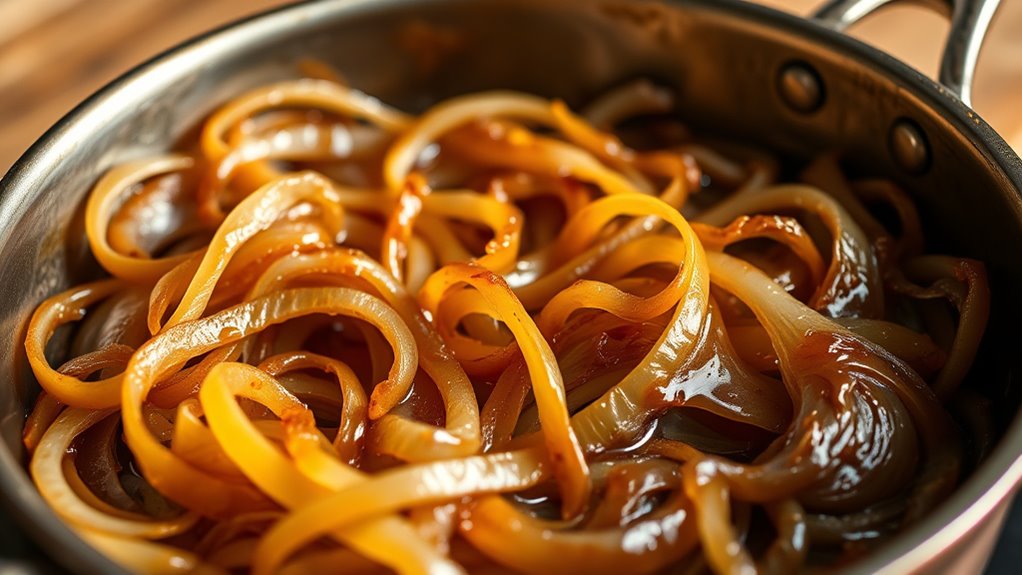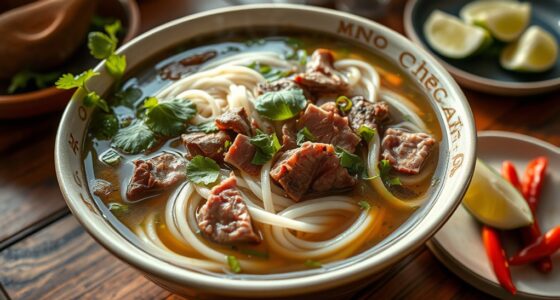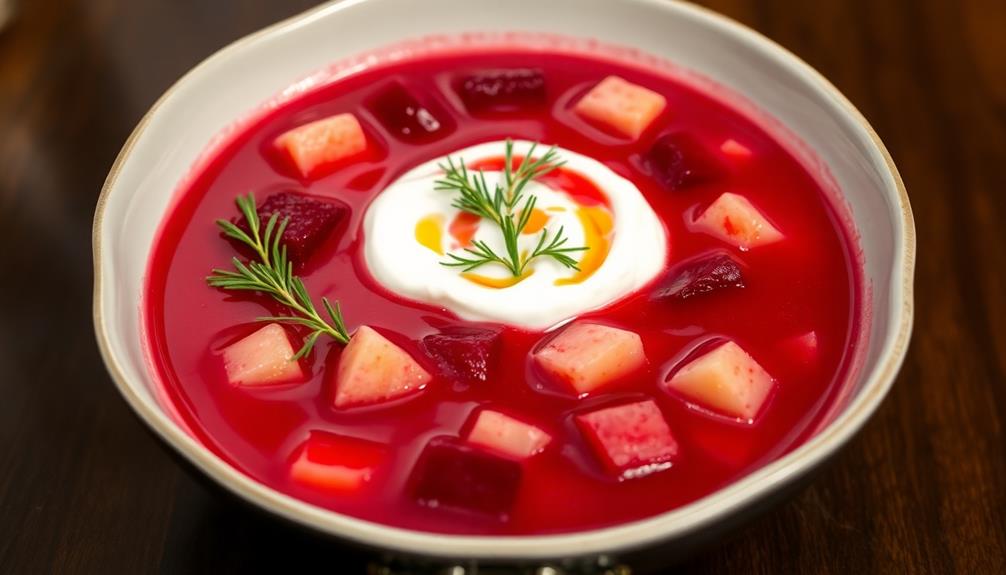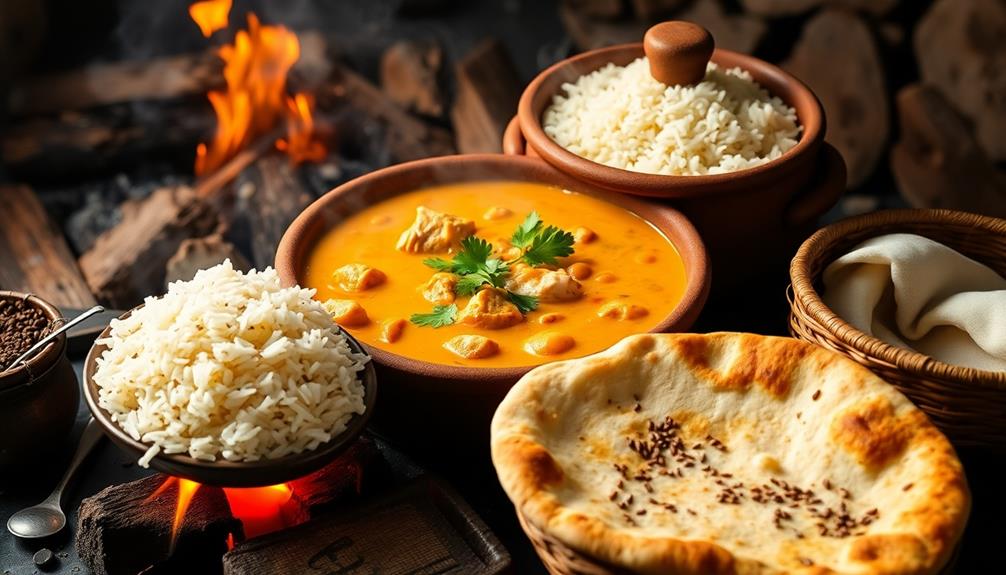To craft authentic French Onion Soup, you need to slow caramelize your onions for ideal flavor. Slice them evenly and cook over low to medium heat, stirring occasionally, for 30-45 minutes. This gentle process allows natural sugars to break down and develop a deep amber color, creating rich, sweet flavors. Managing heat carefully prevents burning and maximizes sweetness. Keep going to discover how mastering this chemistry brings your soup to restaurant-quality perfection.
Key Takeaways
- Evenly sliced onions ensure uniform heat distribution, promoting consistent caramelization and flavor development.
- Slow cooking over low to medium heat allows natural sugars to undergo chemical changes, deepening flavor.
- Controlling temperature prevents burning sugars, avoiding bitterness and ensuring rich, golden-brown onions.
- Stirring occasionally helps release browned bits, enhancing the broth’s complexity and depth.
- Patience during extended cooking concentrates onion sugars, resulting in a sweeter, more flavorful French Onion Soup.

Have you ever wondered how to make a rich, comforting French onion soup from scratch? The secret isn’t just in the ingredients but in the meticulous process of caramelizing onions. You’ll want to focus on understanding onion sugar and the caramelization chemistry that transforms simple onions into a sweet, savory base for your soup. When you start, slice your onions evenly; thin slices cook more uniformly and allow the sugars to develop fully. As you heat your pan, add a bit of butter or oil, and then toss in the onions. The goal is to cook them slowly over low to medium heat. Rushing this step risks burning the onions or ending up with underdeveloped flavors.
Master the art of caramelizing onions slowly for rich, flavorful French onion soup.
The key here is patience, and that’s where onion sugar plays a vital role. Onions naturally contain sugars, and as they cook, these sugars undergo a chemical change called caramelization. Caramelization chemistry involves the breakdown of sugars at high heat, producing new compounds that give the onions a deep, golden-brown hue and a complex, sweet aroma. When you cook onions slowly, these sugars gradually break down, and the flavors intensify. You’ll notice the onions go from translucent to a rich amber, and that’s when you know you’re on the right track. The process can take anywhere from 30 to 45 minutes, depending on the quantity and heat level.
During caramelization, the onion sugar concentration increases, and the chemical reactions produce a variety of flavorful compounds. This transformation is crucial because it forms the foundation of the soup’s signature depth. The longer you cook, the more these flavors concentrate, creating a natural sweetness that balances the savory beef or vegetable stock you’ll add later. It’s worth resisting the temptation to turn up the heat because high temperatures can cause the sugars to burn, resulting in a bitter taste rather than the desired sweet, caramel notes. Stir occasionally to ensure even caramelization and avoid sticking or burning. Additionally, understanding the filtration process of removing impurities from the onions can aid in achieving the clearest broth possible, highlighting the depth of the caramelized onions.
Properly managing the temperature control during caramelization is essential to prevent burning and ensure optimal flavor development. Once your onions reach that perfect deep amber color, you’ve successfully harnessed caramelization chemistry. This slow process unlocks the full potential of onion sugar, giving your French onion soup its rich, layered flavor. This step is also enhanced by understanding the importance of sugar content in onions, which varies between onion varieties and influences caramelization speed and flavor. The final step involves deglazing the pan with a splash of wine or broth, scraping up those flavorful browned bits, and simmering everything together. With patience and attention to detail, you’ll create a profoundly flavorful base that elevates your homemade French onion soup to restaurant-quality.
Frequently Asked Questions
What Type of Onions Best Caramelize for French Onion Soup?
You should use yellow onions for caramelization in French onion soup because their natural sugars develop beautifully when cooked slowly. Their balanced flavor enhances the soup’s richness. Red onions can work too, but they tend to be sharper. White onions are milder but don’t caramelize as deeply. Mastering caramelization techniques involves patience, low heat, and stirring often, allowing the sugars to break down gradually and create that perfect, sweet, savory flavor.
How Does the Pan Material Affect Caramelization?
The pan material greatly impacts caramelization because of its conductivity. You’ll find that a pan with good heat conductivity, like copper or stainless steel, helps distribute heat evenly, preventing hot spots that can burn the onions. A nonstick surface makes it easier to stir and reduces sticking, but it may not conduct heat as well. For best results, choose a pan that balances good conductivity with a nonstick surface for easy caramelization.
Can Caramelized Onions Be Prepared in Advance?
Yes, you can prepare caramelized onions in advance. Store them in an airtight container in the refrigerator for up to 3 days. To preserve their flavor and texture, reheat them gently on the stove or in the microwave. For flavor enhancements, consider adding a splash of balsamic vinegar or a pinch of sugar before reheating. Proper storage tips ensure your onions stay delicious and ready to elevate your dishes anytime.
What’S the Ideal Temperature for Slow Caramelization?
Think of slow caramelization as a gentle sunrise, warming your onions to reveal their sweetness. Keep your stove at a low to medium-low temperature, around 250°F to 300°F (120°C to 150°C). This gentle heat lets sugars—whether from onion varieties like yellow or red—or sugar alternatives slowly develop, creating that rich, golden color and deep flavor without burning. Patience turns everyday onions into a culinary masterpiece.
How Does Adding Sugar Influence the Caramelization Process?
Adding sugar influences the caramelization process by acting as sugar’s role in speeding up the browning of onions. It helps enhance flavor, making the onions sweeter and richer. Sugar creates a faster Maillard reaction, which intensifies the caramel color and deepens the overall taste. Just a pinch can improve the depth of flavor, but be careful not to add too much, or it could overpower the natural onion sweetness.
Conclusion
As you master the art of caramelizing onions, remember that patience is key—taking your time develops the rich, sweet flavor essential for authentic French onion soup. Did you know that slowly caramelized onions contain nearly twice the antioxidants of raw ones? So, next time you cook, embrace the slow process; it’s what transforms simple ingredients into a comforting, flavorful masterpiece you’ll love sharing. Happy cooking!









